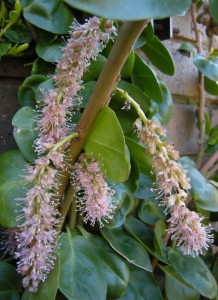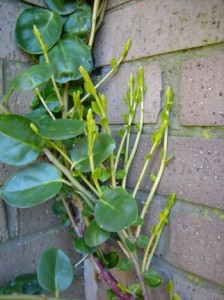Ercilla volubilis collected in Chile during 1996 by the ICE team, a collaboration between the Royal Botanic Garden and the Instituto de Investigaciones Ecologicas Chiloe. It was observed in the wild growing to 3m in height with clusters of fleshy orange-red fruits. Located at the giddy altitudinal height of 14m, inland from the coast by 1km, forming the original coastal forest margin.
At Edinburgh, it is growing very successfully with the protection of a south facing wall behind it in the Chilean area to the north of the Glasshouses, with the support of which it has reached 2m+. Fresh growth in a favourable south west lee of the wall has already shot to 200mm this year.
Brown adhesive pads emanate from behind the leaf axils to hold the stems to the brickwork. It is essential these grip into the bricks surface when the vigorous growth is young as the combined weight of stem, leaves and flowers will cause growth to collapse away from the wall. Where this happens it is best to cut these out and allow fresh shoots to fill the space.
The evergreen leaves are ovate rounded with a firm feel to them. From the leaf axils the flowers drop out on stalks 75mm in length, not attractive, but noticeable. The ball-shaped buds open and the whole drooping spike then resembles a faded pink candyfloss-like tail up to 60mm long. Having a slight musty fragrance, more noticeable as the temperature rises. These also attract early bees on the lookout for a nectar source.


